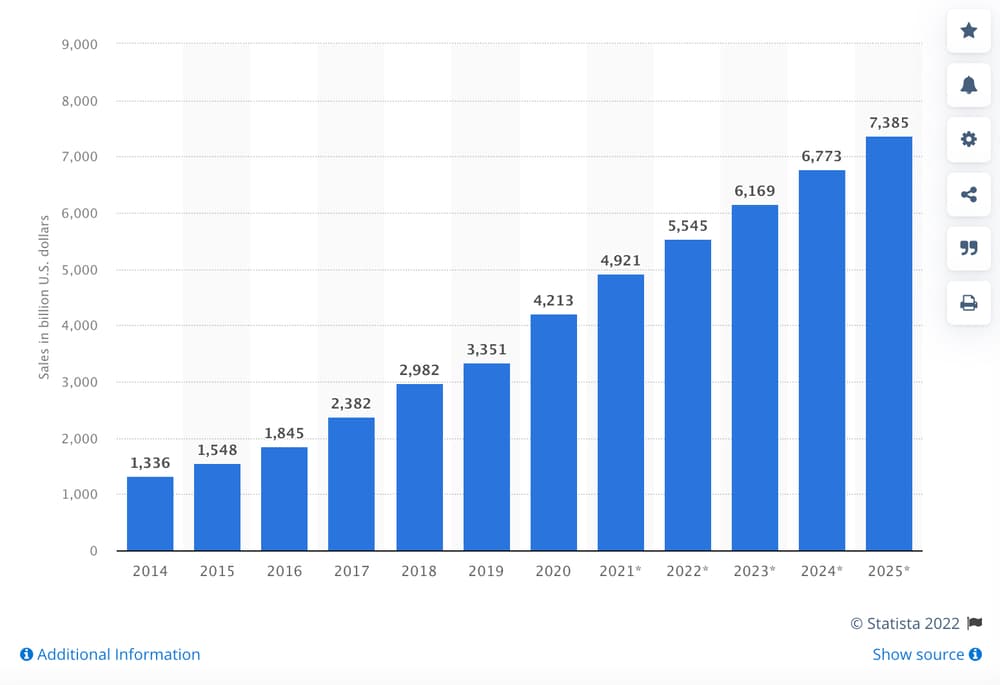E-commerce statistics…whether it’s motivating our desire to start a new business, admiring the rapid growth of the e-commerce industry, or looking for little tidbits.
To help sellers all over the world, these e-commerce statistics often clarify/confirm our decisions and lead us to new conclusions.
The only problem is that most of the statistics you find online are either outdated or highly inaccurate. This is because statistical articles are rarely updated, or you may find that some blogs try to sensationalize information or cherry-pick it to get their point across. That’s why we are here to help you 🙂
E-commerce statistics worldwide 2022
If you already have an e-commerce project or plan to launch one in 2023, it’s important to take the time to keep up with the latest e-commerce trends.
To get started, here are a few eCommerce statistics to keep in mind.
- E-commerce sales are projected to reach $7.4 trillion by 2025ю
- In 2021, e-commerce retail sales worldwide were estimated at $4.9 trillion.
- That number is projected to grow by 50% over the next four years, reaching about $7.4 trillion by 2025.
- The average customer makes 19 online transactions a year.
Let’s talk numbers
95% of purchases, regardless of type, will be made online by 2040, according to Nasdaq.
Experts predict that most online sales will be made through mobile devices.
Men spend 65% more per transaction than women
According to KPMG, men spend about 68% more money on their transactions than women. This is because they are more likely to buy luxury goods and electronics and buy in bulk than women. Women are more likely to buy food and cosmetics, which cost less.
Men maximize their time online and thus spend more money because of it. If you want to increase sales to your male audience in the e-commerce marketplace, try offering packages. Men are more likely to take the time to realize that they can buy a big package at one time and spend more money at a time – so they don’t have to come back later – than a woman.
Internet users all over the world are becoming increasingly involved in online shopping – 93.5% have shopped online
According to OptinMonster, both email and social media marketing can influence the buying behavior of global Internet users.
While social media marketing offers ways to engage socially before a purchase decision is made, email marketing is also very important for promoting brands and leveraging the power of audio-visual content to increase traffic, sales, conversions, and even higher ROI.
Internet customers are becoming more active online, with about 30% posting reviews and leaving feedback
Although reviews are not available in conventional stores, they can influence the decision to buy online. Keep in mind that it is now an integral part of shopping online. The marketplace is where shoppers can exchange information about companies and products. This can be good for consumers, but it can seriously harm sales if the product doesn’t do what it’s supposed to do.
Credit cards are used worldwide to send online payments – they are used in 53% of transactions, followed by digital payment systems (43%) and debit cards (38%).
According to Kinsta, the percentage distribution shows that credit card use is the most preferred method. Western Europe and China still prefer digital payment methods such as Strip, PayPal, and other related methods. On the other hand, the Middle East, Africa, and Eastern Europe still prefer cash on delivery.
Offline holiday shopping accounts for 76% of customers worldwide.
According to GeoMarketing, customers may search for products or vacation items online, but 76 percent will visit those physical stores in person to buy their favorite holiday items for their loved ones. Their smartphones are mostly used to find stores (27 percent), find deals (18 percent), compare prices (13 percent), and research products online (6 percent).
And here we are: available e-commerce statistics demonstrate that there are many ways to view the profitable aspects of buying and selling services online.
0



